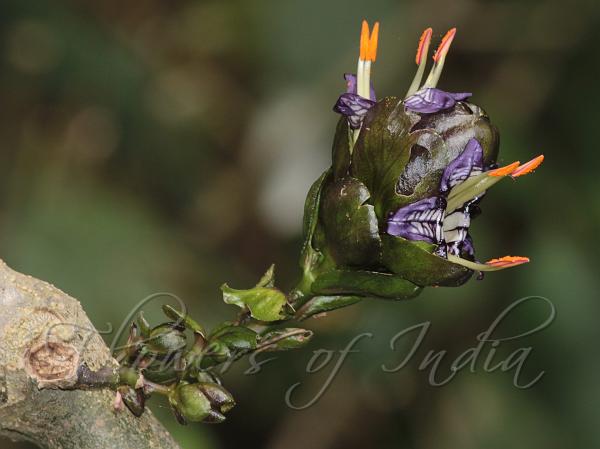|
| Lurid Coneflower |
|

|

| File size | 456880 |
| Original date | 9/4/18 3:12 PM |
| Resolution | 2048 x 1536 |
| Flash | Flash fired |
| Focal length | 135.0mm |
| Exposure time | 1/200s |
| Aperture | 10.0 |
| Focus Distance | |
| Metering Mode | Multi-segment |
| Camera make | Canon |
| Camera model | Canon EOS 700D |
| Sensor type |
|
|
|
|
Photo: |
Botanical name: Strobilanthes luridus Family: Acanthaceae (Acanthus family)
Synonyms: Didyplosandra lurida
Synonyms: Didyplosandra lurida
Lurid Coneflower is a large straggling branched shrub,
with stem thick, virgate, swollen at nodes, hairless. Flowers are borne
in spikes, from older stems, often from near ground, opposite, rising
up, uninterrupted, compact, about 8 x 4.5 cm, bristly.
Flower-cluster-stalks are about 4 cm long. Bracts are round, large,
about 2.5 x 2 cm, entire or wavy at margin, pointed, notched or flat at
tip, ribbed, purple with black tinge; bracteoles are 2, strap-shaped,
about 1.8 cm, pointed, white. Calyx is about 2 cm long, 5-lobed, near
to the base; sepals lanceshaped, slightly enlarged in fruit with a row
of bristles on lower face, finely ridged, about 2.2 cm long. Flowers
are somewhat two-lipped, about 3 cm long, exceeding large dull bracts,
tubular-swollen, purple, attractive. Flower-tube is about 2 mm long;
swollen portion widening above gradually, hairless outside, hairy
inside, 5-petalled. Petals are ovate, blunt, about 3 mm long. Stamens
are 4, equal, united in pairs at base forming a staminal sheath,
protruding; filaments about 1.5 cm long. Ovary is on a prominent disc,
about 2.5 mm; style slender, about 2.5 cm long; stigma bilobed. Leaves
are opposite, about 20 x10 cm, ovate-elliptic, blunt towards base,
sawtoothed at margin, tapering at tip, leathery, hairy, densely so
beneath; leaf-stalks up to 5 cm long, faintly hairy. Capsules are
ovoid-ellipsoid, about 2 cm long, tapering, hairless, included in
bracts. Lurid Coneflower is endemic to Southern Western Ghats.
Flowering: December-April.
| Identification credit: Prashant Awale | Photographed in Shola forest, Munnar, Kerala. |
• Is this flower misidentified? If yes,